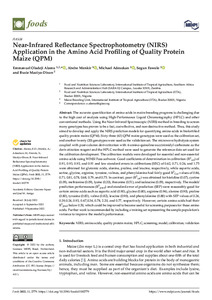| dc.identifier.citation | Alamu, E.O., Menkir, A., Adesokan, M., Fawole, S. & Maziya-Dixon, B. (2022). Near-Infrared Reflectance Spectrophotometry (NIRS) application in the amino acid profiling of Quality Protein Maize (QPM). Foods, 11(18): 2779, 1-10. |
| dc.description.abstract | The accurate quantification of amino acids in maize breeding programs is challenging due to the high cost of analysis using High-Performance Liquid Chromatography (HPLC) and other conventional methods. Using the Near-Infrared Spectroscopic (NIRS) method in breeding to screen many genotypes has proven to be a fast, cost-effective, and non-destructive method. Thus, this study aimed to develop and apply the NIRS prediction models for quantifying amino acids in biofortified quality protein maize (QPM). Sixty-three (63) QPM maize genotypes were used as the calibration set, and another twenty (20) genotypes were used as the validation set. The microwave hydrolysis system coupled with post-column derivatization with 6-amino-quinoline-succinimidyl-carbamate as the derivatization reagent and the HPLC method were used to generate the reference data set used for the calibration development. The calibration models were developed for essential and non-essential amino acids using WINSI Foss software. Good coefficients of determination in calibration (R2cal) of 0.91, 0.93, 0.93, and 0.91 and low standard errors in calibrations (SEC) of 0.62, 0.71, 0.26, and 1.75 were obtained for glutamic acids, alanine, proline, and leucine, respectively, while aspartic acids, serine, glycine, arginine, tyrosine, valines, and phenylalanine had fairly good R2Cal values of 0.86, 0.71, 0.81, 0.78, 0.68, 0.79, and 0.75. In contrast, poor (R2cal) was obtained for histidine (0.07), cystine (0.09), methionine (0.09), lysine (0.20), threonine (0.51), and isoleucine (0.09), respectively. The models’ prediction performances (R2pred) and standard error of prediction (SEP) were reasonably good for certain amino acids such as aspartic acid (0.90), glycine (0.80), arginine (0.94), alanine (0.90), proline (0.80), tyrosine (0.83), valine (0.82), leucine (0.90), and phenylalanine (0.88) with SEP values of 0.24, 0.39,0.24, 0.93, 0.47,0.34, 0.78, 2.20, and 0.77, respectively. However, certain amino acids had their R2pred below 0.50, which could be improved to become useful for screening purposes for those amino acids. Further work is recommended by including a training set representing the sample population’s variance to improve the model’s performance. |

